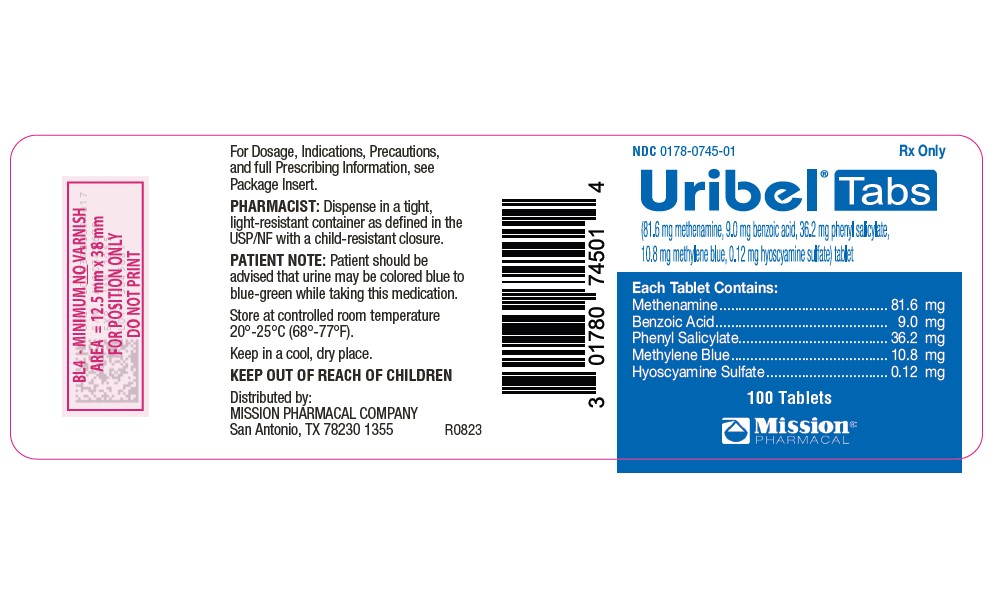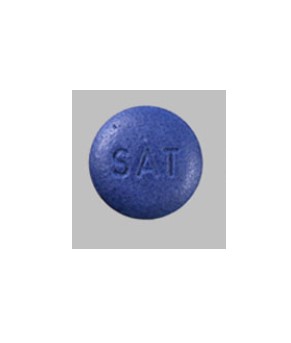DESCRIPTION
Uribel® Tabs for oral administration
Each tablet contains:
Methenamine .........................................................................................................................81.6 mg
Benzoic Acid ..........................................................................................................................9.0 mg
Phenyl Salicylate ...................................................................................................................36.2 mg
Methylene Blue ......................................................................................................................10.8 mg
Hyoscyamine Sulfate..............................................................................................................0.12 mg
HYOSCYAMINE SULFATE. [620-61-1][3(S)-endo]-α-(Hydroxymethyl)-benzeneacetic acid 8-methyl-8-azabicyclo[3.2.1]oct-3-yl ester sulfate(2:1)(salt); 1αH, 5αH-tropan-3α-ol(-)- tropate(ester) sulfate(2:1)(salt); 3α-tropanyl S-(-)-tropate; I-tropic acid ester with tropine; I-tropine tropate. C 34H 48N 2O 10S. Hyoscyamine Sulfate is an alkaloid of belladonna. Exists as a white crystalline powder. Its solutions are alkaline to litmus. Affected by light, it is slightly soluble in water; freely soluble in alcohol; sparingly soluble in ether.
METHENAMINE. [100-97-0] 1,3,5,7-Tetraazatricyclo [3.3.1.-1 3,7] decane; hexamethylenetetramine; HMT; HMTA; hexamine; 1,3,5,7-tetraazaadamantane hexamethyleneimine; Uritone; Urotropin. C 6H 12N 4; mol wt 140.19; C 51.40%, H 8.63%, N 39.96%. Methenamine (hexamethylenetetramine) exists as colorless, lustrous crystals or white crystalline powder. Its solutions are alkaline to litmus. Freely soluble in water, soluble in alcohol and in chloroform.
METHYLENE BLUE. [61-73-4] 3,7-Bis(dimethylamino) phenothiazin-5-ium chloride; C.I. Basic Blue 9; methylthioninium chloride; tetramethylthionine chloride; 3,7-bis(dimethylamino) phenazathionium chloride. C 16H 18ClN 3S; mol wt 319.85, C 60.08%, H 5.67%, Cl 11.08%, N 13.14%, S 10.03%. Methylene Blue (Methylthionine chloride) exists as dark green crystals. It is soluble in water and in chloroform; sparingly soluble in alcohol.
PHENYL SALICYLATE. [118-55-8] 2-Hydroxybenzoic acid phenyl ester; Salol. C 13H 10O 3; mol wt 214.22, C 72.89%, H 4.71%, O 22.41%. Made by the action of phosphorus oxychloride on a mixture of phenol and salicylic acid. Phenyl Salicylate exists as white crystals with a melting point of 41°-43°C. It is very slightly soluble in water and freely soluble in alcohol.
BENZOIC ACID. [65-85-0] Benzenecarboxylic acid; Benzeneformic acid; Benzenemethanoic acid. C 7H 6O 2; mol wt 122.12, C 68.85%, H 4.95%, O 26.20%. Exists as white powder or crystals, scales or needles. It has a strong odor and is slightly soluble in alcohol; also soluble in volatile and fixed oils, slightly soluble in petroleum ether.
Uribel Tabs contain inactive ingredients: Crospovidone, FD&C Blue #2, Magnesium Stearate, Microcrystalline Cellulose, Polyethylene Glycol, Polyvinyl Alcohol, Rice Starch, Silicon Dioxide, Sodium Starch Glycolate, Stearic Acid, Talc, and Titanium Dioxide.
CLINICAL PHARMACOLOGY
HYOSCYAMINE SULFATE is a parasympatholytic which relaxes smooth muscles and thus produces an antispasmodic effect. It is well absorbed from the gastrointestinal tract and is rapidly distributed throughout the body tissues. Most is excreted in the urine within 12 hours, 13% to 50% being unchanged. Its biotransformation is hepatic. Its protein binding is moderate.
METHENAMINE degrades in an acidic urine environment releasing formaldehyde which provides bactericidal or bacteriostatic action. It is well absorbed from the gastrointestinal tract. 70%-90% reaches the urine unchanged at which point it is hydrolyzed if the urine is acidic. Within 24 hours it is almost completely (90%) excreted; of this at a pH of 5, approximately 20% is formaldehyde. Protein binding - some formaldehyde is bound to substances in the urine and surrounding tissues. Methenamine is freely distributed to body tissue and fluids but is not clinically significant as it does not hydrolyze at pH greater than 6.8.
METHYLENE BLUE possesses weak antiseptic properties. It is well absorbed by the gastrointestinal tract and rapidly reduced to leukomethylene blue which is stabilized in some combination form in the urine. 75% is excreted unchanged.
PHENYL SALICYLATE releases salicylate, a mild analgesic for pain.
BENZOIC ACID helps maintain an acid pH in the urine necessary for the degradation of methenamine.
INDICATIONS AND USAGE
Uribel Tabs are indicated for the treatment of symptoms of irritative voiding. Indicated for the relief of local symptoms, such as inflammation, hypermotility, and pain, which accompany lower urinary tract infections. Indicated for the relief of urinary tract symptoms caused by diagnostic procedures.
CONTRADICTIONS
Hypersensitivity to any of the ingredients is possible. Risk benefits should be carefully considered when the following medical problems exist: cardiac disease (especially cardiac arrhythmias, congestive heart failure, coronary heart disease, and mitral stenosis); gastrointestinal tract obstructive disease; glaucoma; myasthenia gravis, acute urinary retention may be precipitated in obstructive uropathy (such as bladder neck obstruction due to prostatic hypertrophy).
WARNINGS
Do not exceed recommended dosage. If rapid pulse, dizziness or blurring of vision occurs, discontinue
use immediately.
PRECAUTIONS
Cross sensitivity and/or related problems
Patients intolerant of belladonna alkaloids or salicylates may be intolerant of this medication also. Delay in gastric emptying could complicate the management of gastric ulcers.
Pregnancy/Reproduction (FDA Pregnancy Category C)
Hyoscyamine and methenamine cross the placenta. Studies concerning the effect of hyoscyamine and methenamine on pregnancy and reproduction have not been done in animals or humans. Thus, it is not known whether Uribel Tabs cause fetal harm when
administered to a pregnant woman or can affect reproduction capacity. Uribel Tabs should be given to a pregnant woman only if clearly needed.
Breastfeeding
Problems in humans have not been documented; however, methenamine and traces of hyoscyamine are excreted in breast milk. Accordingly, Uribel Tabs should be given to a nursing mother with caution and only if clearly needed.
Prolonged use
There have been no studies to establish the safety of prolonged use in humans. No known long-term animal studies have been performed to evaluate carcinogenic potential.
Pediatric use
Infants and young children are especially susceptible to the toxic effect of the belladonna alkaloids.
Geriatric use
Use with caution in elderly patients as they may respond to usual doses of hyoscyamine with excitement, agitation, drowsiness or confusion.
ADVERSE REACTIONS
Cardiovascular: rapid heartbeat, flushing
Central Nervous System: blurred vision, dizziness, drowsiness
Genitourinary: difficult micturition, acute urinary retention
Gastrointestinal: dry mouth, nausea and vomiting
Respiratory: shortness of breath or trouble breathing
Serious allergic reactions to this drug are rare. Seek immediate medical attention if you notice symptoms of a serious allergic reaction, including itching, rash, severe dizziness, swelling or trouble breathing.
This medication can cause urine and sometimes stools to turn blue to blue-green. This effect is harmless and will subside after medication is stopped.
Call your doctor or physician for medical advice about side effects. To report SUSPECTED ADVERSE
REACTIONS, contact Mission Pharmacal at 1-800-298-1087 or FDA at 1-800-FDA-1088,
www.fda.gov/medwatch.
Drug interactions
As a result of hyoscyamine's effects on gastrointestinal motility and gastric emptying, absorption of other oral medications may be decreased during concurrent use with this combination medication. Methylene blue inhibits a range of CYP isozymes in vitro, including 1A2, 2B6, 2C8, 2C9, 2C19, 2D6 and 3A4/5. This interaction could be more pronounced with narrow therapeutic index drugs that are metabolized by one of these enzymes (e.g., digoxin, warfarin, phenytoin, alfentanil, cyclosporine, dihydroergotamine, ergotamine, fentanyl, pimozide, quinidine, sirolimus and tacrolimus). However, the clinical relevance of these in vitro interactions is unknown.
Urinary alkalizers and thiazide diuretics
May cause the urine to become alkaline reducing the effectiveness of methenamine by inhibiting its conversion to formaldehyde.
Antimuscarinics: Concurrent use may intensify antimuscarinic effects of hyoscyamine because of secondary antimuscarinic activities of these medications.
Antacids/antidiarrheals
Concurrent use may reduce absorption of hyoscyamine resulting in decreased therapeutic effectiveness. Concurrent use with antacids may cause urine to become alkaline reducing the effectiveness of methenamine by inhibiting its conversion to formaldehyde. Doses of these medications should be spaced 1 hour apart from doses of hyoscyamine.
Antimyasthenics
Concurrent use with hyoscyamine may further reduce intestinal motility, therefore, caution is recommended. Ketoconazole and hyoscyamine may cause increased gastrointestinal pH. Concurrent administration with hyoscyamine may result in marked reduction in the absorption of ketoconazole. Patients should be advised to take this combination at least 2 hours after ketoconazole.
Monoamine oxidase (MAO) inhibitors
Concurrent use with hyoscyamine may intensify antimuscarinic side effects.
Opioid (narcotic) analgesics may result in increased risk of severe constipation.
Sulfonamides
These drugs may precipitate with formaldehyde in the urine increasing the danger of crystalluria. Patients should be advised that the urine and/or stools may become blue to blue-green as a result of the excretion of methylene blue.
DRUG ABUSE AND DEPENDENCE
A dependence on the use of Uribel Tabs has not been reported and due to the nature of its ingredients, abuse of Uribel Tabs is not expected.
OVERDOSE
Emesis or gastric lavage. Slow intravenous administration of physostigmine in doses of 1 to 4 mg (0.5 to 1 mg in children), repeated as needed in one to two hours to reverse severe antimuscarinic symptoms.
Administration of small doses of diazepam to control excitement and seizures. Artificial respiration with oxygen if needed for respiratory depression. Adequate hydration. Symptomatic treatment as necessary.
If overdose is suspected, contact your local Poison Control Center or emergency room immediately.
US residents can contact the US National Poison Hotline at 1-800-222-1222.
DOSAGE AND ADMINISTRATION
Adults
One tablet orally 4 times per day followed by liberal fluid intake.
Older Children
Dosage must be individualized by physician.
Not recommended for use in children six years of age or younger.
HOW SUPPLIED
Uribel Tabs are blue tablets imprinted with “SAT” on one side and “109” on opposite side.
NDC 0178-0745-01, bottle of 100 tablets.
 Rx Only
Rx Only
